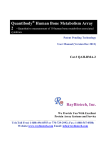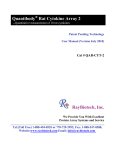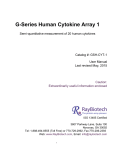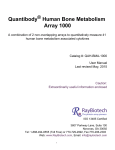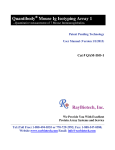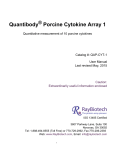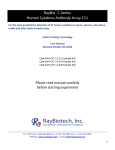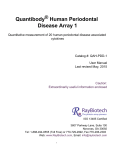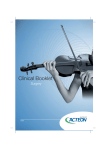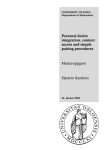Download User Manual - RayBiotech, Inc.
Transcript
G-Series Human Bone Metabolism Array 1 Semi-quantitative measurement of 31 human bone metabolism associated cytokines Catalog #: GSH-BMA-1 User Manual Last revised May, 2015 Caution: Extraordinarily useful information enclosed ISO 13485 Certified 3607 Parkway Lane, Suite 100 Norcross, GA 30092 Tel: 1-888-494-8555 (Toll Free) or 770-729-2992, Fax:770-206-2393 Web: www.RayBiotech.com, Email: [email protected] 1 Table of Contents Section Page # I. Overview 3 II. Introduction 3 III. How It Works 4 IV. Materials Provided 5 V. Storage 5 VI. Additional Materials Required 5 VII. General Considerations A. Sample Preparation B. Handling Glass Slides C. Incubation 6 6 VIII. Protocol A. Completely Air Dry The Glass Slide B. Blocking & Incubation C. Incubation with Biotinylated Antibody Cocktail & Wash D. Incubation with Cy3 Equivalent Dye-Streptavidin & Wash E. Fluorescence Detection F. Data Analysis 7 7 7 8 8 9 10 IX. Array Map 11 X. Analysis Tool: Data Analysis Software 12 XI. Troubleshooting Guide 13 XII. Select Publications 14 XIII. Experiment Record Form 15 XIV. How To Choose An Array 16 6 Please read the entire manual carefully before starting your experiment 2 I. Overview Cytokines Detected (31) Format Detection Method Activin A, aFGF (FGF-1), Amphiregulin, bFGF, BMP-4, BMP9, E-Selectin, ICAM-1 (CD54), IGF-1, IL-1 alpha (IL-1 F1), IL1 beta (IL-1 F2), IL-6, IL-8 (CXCL8), IL-11, IL-17A, MCP-1 (CCL2), M-CSF, MIP-1 alpha (CCL3), MMP-2, MMP-9, MMP13, Osteoactivin (GPNMB), P-Cadherin, RANK (TNFRSF11A), SDF-1 alpha (CXCL12 alpha), Sonic Hedgehog N-Terminal (Shh-N), TGF beta 1, TGF beta 2, TNF alpha, VCAM-1 (CD106), VE-Cadherin (CDH5) See Section IX for Array Map One standard glass slide is spotted with 16 wells of identical cytokine antibody arrays. Each antibody is arrayed in quadruplicate. Fluorescence. Go to www.RayBiotech.com/Scanners for a list of compatible laser scanners. Sample Volume 50 - 100 µl per array Reproducibility CV <20% Assay Duration 6 hours II. Introduction Bone is a metabolically active tissue that undergoes continuous remodeling by two counter acting processes, namely bone formation (osteoblasts) and bone resorption (osteoclasts). Under normal conditions, bone resorption and formation are tightly regulated by various hormones (e.g. PTH, vitamin D, steroids, and calcitonin) and local mediators (e.g. cytokines and growth factors). Bone resorption requires the presence of RANKL and M-CSF, and is inhibited by OPG. Bone formation is induced by many growth factors, in particular the BMPs, FGF, PDGF, and TGFb; and is regulated by M-CSF, ALP, osteocalcin, osteopontin, and osteonectin. An imbalance in the regulation of bone resorption and bone formation results in many metabolic bone diseases, such as osteoporosis, osteoarthritis, rheumatoid arthritis, and bone metastases. RayBio® G-Series Arrays are glass slide-based antibody arrays which allow researchers to conduct rapid, accurate expression profiling of hundreds of cytokines, chemokines, growth 3 factors, proteases, soluble receptors and other proteins from any biological fluid. Like a traditional sandwich-based ELISA, this array uses a matched pair of cytokine-specific antibodies for detection. After incubation with the sample, the target cytokines are captured by the antibodies printed on the solid surface. A second biotin-labeled detection antibody is then added, which recognizes a different epitope of the target cytokine. The cytokineantibody-biotin complex can then be visualized through the addition of the streptavidinconjugated Cy3 equivalent dye. Like the Quantibody® arrays, G-Series utilizes a highly sensitive and stable fluorescent readout which can be detected by most laser fluorescent scanner systems. After capturing the spot densities with a laser scanner, normalization of the raw data can be easily calculated by the researcher, or by a quick copy-paste into our excelbased Analysis Tool software. This array as well as all catalog numbers beginning with 'GS' differ from the classic G-Series Arrays in a few important ways. First, each capture antibody is printed in quadruplicate instead of duplicate, delivering higher precision. Secondly, this array features the same antibody panels used in our Quantibody Arrays, allowing a seamless transition to our quantitative multiplex assay platform. Lastly, all 16 wells are spotted as sub-arrays, delivering easy handling of 16 samples simultaneously while consuming low sample volumes (10 - 100 µl per array). III. How It Works 4 5 IV. Materials Provided Component Name 1 Slide Box 2 Slide Box* 1 GSH-BMA-1S Human Bone Metabolism Array 1 Glass Slide 1 2 2 QA-SDB Sample Diluent 3 AA-WB1-30ML 20X Wash Buffer I 4 AA-WB2-30ML 20X Wash Buffer II 5 GSH-BMA-1B Human Bone Metabolism Array 1 Biotinylated Antibody Cocktail 6 QA-CY3E Cy3 equivalent dye-conjugated Streptavidin 7 QA-SWD Slide Washer/Dryer 1 x 30 ml Tube 8 QA-ADH Adhesive Film 1 Catalog # 15 ml 2 x 30 ml 3 x 30 ml 30 ml 1-25 µl 2 x 1-25 µl 5 µl 2 x 5 µl 2 * 4 slide kits are comprised of 2 separate 2 slide kits. V. Storage Upon receipt, all components should be stored at -20°C. The kit will retain activity for up to 6 months. Once thawed, the glass slide, antibody cocktail and dyeconjugated Streptavidin should be kept at -20°C. All other components may be stored at 4°C. The entire kit should be used within 6 months of purchase. VI. Additional Materials Required Benchtop rocker or orbital rocker Laser scanner for fluorescence detection Aluminum foil Distilled water 1.5 ml Polypropylene microcentrifuge tubes 6 VII. General Considerations A. Preparation of Samples Use serum-free conditioned media if possible. If serum-containing conditioned media is required, it is highly recommended that complete medium be used as a control since many types of sera contains cytokines. We recommend the following parameters for your samples: 50 to 100 µl of original or diluted serum, plasma, cell culture media, or other body fluid, or 50500 µg/ml of protein for cell and tissue lysates. If you experience high background or if the fluorescent signal intensities exceed the detection range, further dilution of your sample is recommended. B. Handling Glass Slides Do not touch the surface of the slides, as the microarray slides are very sensitive. Hold the slides by the edges only. Handle all buffers and slides with powder free gloves. Handle glass slide/s in clean environment. The GS-Series slides do not have bar codes. To help distinguish one slide from another, transcribe the slide serial number from the slide bag to the back of the slide with a fine point permanent marker. Please write the number on the very bottom edge of the slide, taking care to avoid writing on the array well areas. C. Incubation Completely cover array area with sample or buffer during incubation. Avoid foaming during incubation steps. Perform all incubation and wash steps under gentle rocking or rotation. Cover the incubation chamber with adhesive film during incubation, particularly when incubation is more than 2 hours or <70 µl of sample or reagent is used. Several incubation steps such as step 6 (blocking), step 7 (sample incubation), step 10 (detection antibody incubation), or step 13 (Cy3 equivalent dyestreptavidin incubation) may be done overnight at 4°C. Please make sure to cover the incubation chamber tightly to prevent evaporation. 7 VIII. Protocol A. Completely Air Dry The Glass Slide 1. Take out the glass slide from the box, and let it equilibrate to room temperature inside the sealed plastic bag for 20-30 minutes. Remove slide from the plastic bag, peel off the cover film, and let it air dry for another 1-2 hours. Incomplete drying of slides before use may cause the formation of "comet tails," thin directional smearing of antibody spots. B. Blocking & Incubation 2. Add 100 µl Sample Diluent into each well and incubate at room temperature for 30 minutes to block slides. 3. Decant buffer from each well. Add 100 µl of sample to each well. Incubate arrays at room temperature for 1-2 hour. Longer incubation time is preferable for higher signals. This step may be done overnight at 4°C. We recommend using 50 to 100 µl of original or diluted serum, plasma, conditioned media, or other body fluid, or 50-500 µg/ml of protein for cell and tissue lysates. Cover the incubation chamber with adhesive film during incubation, especially if less than 70 ul of sample or reagent is used. 4. Wash: Decant the samples from each well, and wash 5 times (5 min each) with 150 µl of 1X Wash Buffer I at room temperature with gentle shaking. Completely remove wash buffer in each wash step. Dilute 20x Wash Buffer I with H2O. (Optional for Cell and Tissue Lysates) Put the glass slide with frame into a box with 1X Wash Buffer I (cover the whole glass slide and frame with Wash Buffer I), and wash at room temperature with gentle shaking for 20 min. 8 Decant the 1x Wash Buffer I from each well, wash 2 times (5 min each) with 150 µl of 1X Wash Buffer II at room temperature with gentle shaking. Completely remove wash buffer in each wash step. Dilute 20X Wash Buffer II with H2O. Incomplete removal of the wash buffer in each wash step may cause "dark spots," the background signals higher than the spots. C. Incubation with Biotinylated Antibody Cocktail & Wash 5. Reconstitute the detection antibody by adding 1.4 ml of Sample Diluent to the tube. Spin briefly. 6. Add 80 µl of the detection antibody cocktail to each well. Incubate at room temperature for 1-2 hour. Longer incubation time is preferable for higher signals 7. Decant the samples from each well, and wash 5 times (5 mins each) with 150 µl of 1X Wash Buffer I and then 2 times with 150 µl of 1x Wash Buffer II at room temperature with gentle shaking. Completely remove wash buffer in each wash step. D. Incubation with Cy3 Equivalent Dye-Streptavidin & Wash 8. After briefly spinning down, add 1.4 ml of Sample Diluent to Cy3 equivalent dye-conjugated streptavidin tube. Mix gently. 9. Add 80 µl of Cy3 equivalent dye-conjugated streptavidin to each well. Cover the device with aluminum foil to avoid exposure to light or incubate in dark room. Incubate at room temperature for 1 hour. 10. Decant the samples from each well, and wash 5 times (5 mins each) with 150 µl of 1X Wash Buffer I at room temperature with gentle shaking. Completely remove wash buffer in each wash step. 9 E. Fluorescence Detection 11. Disassemble the device by pushing clips outward from the slide side. Carefully remove the slide from the gasket. Be careful not to touch the surface of the array side. 12. Place the slide in the Slide Washer/Dryer (a 4-slide holder/centrifuge tube), add enough 1x Wash Buffer I (about 30 ml) to cover the whole slide, and then gently shake at room temperature for 15 minutes. Decant Wash Buffer I. Wash with 1x Wash Buffer II (about 30 ml) and gently shake at room temperature for 5 minutes. 13. Remove water droplets completely by gently applying suction with a pipette to remove water droplets. Do not touch the array, only the sides. You may also dry the glass slide by a compressed N 2 stream. 14. Imaging: The signals can be visualized through use of a laser scanner equipped with a Cy3 wavelength (green channel) such as Axon GenePix. In case the signal intensity for different cytokine varies greatly in the same array, we recommend using multiple scans, with a higher PMT for low signal cytokines, and a low PMT for high signal cytokines. 10 F. Data Analysis 15. Data extraction can be done using the GAL file that is specific for this array along with the microarray analysis software (GenePix, ScanArray Express, ArrayVision, MicroVigene, etc.). GAL files can be found here: www.RayBiotech.com/Gal-Files.html. Need help analyzing all that data? Copy and paste your data into the QAnalyzer Tool specific for this array, catalog number: GSH-BMA-1-SW. More information can be found in Section X. 11 IX. Array Map 12 X. Array Data Analysis Tool The RayBio Analysis Tools are array specific, Excel-based program that perform sophisticated data analysis on the raw numerical data extracted from the array scan (see below for description). The Analysis Tool specific for this array is catalog number: GSH-BMA-1-SW. Key features: Simplicity: Easy to operate and requires no professional training. With a simple copy and paste process, the cytokine expression levels are determined per sample. Outlier Marking & Removing: The software can automatically mark and remove the outlier spots for more accurate data analysis Normalization: The program allows for intra- and inter-slide normalization for large numbers of samples. Two Positive Controls: The program utilizes the two positive controls in each array for normalization. User Intervention: The program allows for user manual handling of outliers and other analytical data. Analyze Multiple Slide: The data for multiple slides can be inputted for easy slide-to-slide comparison. 13 XI. Troubleshooting Guide Problem Weak Signal Cause Recommendation Inadequate detection Increase laser power and PMT parameters Inadequate reagent volumes or improper dilution Check pipettes and ensure correct preparation Short incubation time Increase incubation time or change sample incubation step to overnight Too low protein Lessen dilution or do not dilute sample. concentration in sample Concentrate sample if necessary. Uneven signal High background Improper storage of kit Store kit as suggested temperature. Don't freeze/thaw the slide. Bubble formed during incubation Decrease amount of rocking/shaking during incubations. check for bubble formation and remove bubbles. Arrays are not completed covered by reagent Completely cover arrays with solution for all required steps. Reagent evaporation Cover the incubation chamber with adhesive film during incubation Overexposure Lower the PMT or sigmal gain. Dark spots Completely remove wash buffer in each wash step. Insufficient wash Increase wash time and use more wash buffer Dust Work in clean environment Slide is allowed to dry out Don't dry out slides during experiment. 14 XII. Select Publications 1. Stechova, et al. Influence of Maternal Hyperglycaemia on Cord Blood Mononuclear 2. 3. 4. 5. 6. 7. 8. 9. 10. 11. 12. Cells in Response to Diabetes-associated Autoantigens. Scandinavian Journal of Immunology. 2009. 70(2):149-158 Willingham, SB et al. NLRP3 (NALP3, Cryopyrin) facilitates in vivo caspase-1 activation, necrosis, and HMGB1 release via inflammasome-dependent and -independent pathways. J Immunol. 2009; 183(3):2008-15 El Karim et al. Neuropeptides Regulate Expression of Angiogenic Growth Factors in Human Dental Pulp Fibroblasts. Journal of Endodontics, 2009; 35(6): 829-833 Souquière S. et al. T-Cell tropism of simian T-cell leukaemia virus type 1 and cytokine profiles in relation to proviral load and immunological changes during chronic infection of naturally infected mandrills (Mandrillus sphinx). J Med Primatol. 2009; 38(4):279-89 Sharma, et al. Induction of multiple pro-inflammatory cytokines by respiratory viruses and reversal by standardized Echinacea, a potent antiviral herbal extract. Antiviral Research. 2009; 83(2)165-170. Altamirano-Dimas, et al. Echinacea and anti-inflammatory cytokine responses: Results of a gene and protein array analysis. Pharmacuetical Biology. 2009; 47(6): 500-508. Cheung, et al. Cordysinocan, a polysaccharide isolated from cultured Cordyceps, activates immune responses in cultured T-lymphocytes and macrophages: Signaling cascade and induction of cytokines. Journal of Ethonopharmacology. 2009; 124(1): 6168. Du, et al. P2-380: Identification and characterization of human autoantibodies that may be used for the treatment of prion diseases. Alzheimers and Dementia. 2009; 4(4): T484T484. Van Rossum et al. Granulocytosis and thrombocytosis in renal cell carcinoma: a proinflammatory cytokine response originating in the tumour. Neth J Med. 2009; 67(5):1914. Zhai, et al. Coordinated Changes in mRNA Turnover, Translation, and RNA Processing Bodies in Bronchial Epithelial Cells following Inflammatory Stimulation. Molecular and Cellular Biology. 2008; 28(24): 7414-7426. Gao, et al. A Chinese herbal decoction, Danggui Buxue Tang, activates extracellular signal-regulated kinase in cultured T-lymphocytes. FEBS Letters, 2007; 581(26): 50875093.This reference validates mulitplex ELISA results for several analytes with standard ELISA test results. Piganelli, et al: Autoreactive T-cell responses: new technology in pursuit of an old nemesis. (Editorial Review) Pediatric Diabetes 2007: 8: 249?251 Note: The citations listed above are for the Quantibody® product line, which is the same as the GS-Series, but include protein standards for quantitation. 15 XIII. Experiment Record Form Date:_______________________ File Name:___________________ Laser Power:_________________ PMT:________________________ Well No. Sample Name Dilution factor 1 2 3 4 5 6 7 8 9 10 11 12 13 14 15 16 16 XIV. How to Choose a GS-Series Array? Species-based selection: Human (GSH-) Mouse (GSM-) Rat (GSR-) Bovine (GSB-) Canine (GSC-) Equine (GSE-) Feline (GSF-) Ovine (GSO-) Primates (GSN-) Porcine (GSP-) Rabbit (GSL-) Function-based selection: Adhesion Molecule Arrays Angiogenesis Arrays Bone Metabolism Arrays Chemokine Arrays Cancer Biomarker Arrays Custom Arrays Cytokine Arrays Growth Factor Arrays IGF Signaling Arrays IL-1 Family Arrays Immune Response Arrays Inflammation Arrays Interleukin Arrays Isotyping Arrays MMP Arrays Obesity Arrays Ophthalmic Arrays Periodontal Disease Arrays Receptor Arrays Th1/Th2/Th17 Arrays Cytokine Number-based selection: Arrays are available in the GS-Series & Quantibody ® platform to detect 660 human, 200 mouse, or 67 rat proteins. GLP-Compliant testing services are also available. This product is for research use only. ©2015 RayBiotech, Inc 17




















